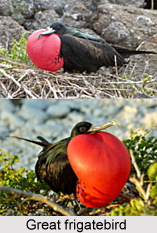 Great Frigatebird is an Indian Bird with a scientific name "Fregata minor" and is a large seabird in the frigatebird family.
Great Frigatebird is an Indian Bird with a scientific name "Fregata minor" and is a large seabird in the frigatebird family.
Nests of Great Frigatebird
The major nesting populations of Great Frigatebird are found in the Pacific (including the Galapagos Islands) and Indian Oceans, as well as a population in the South Atlantic Ocean areas.
Structure of Great Frigatebird
Great Frigatebird is a lightly built, large seabird up to 105 cm long with predominantly black plumage. The species exhibits sexual dimorphism; the female is larger than the adult male and has a white throat and breast, and the male`s scapular feathers have a purple-green sheen.
Breeding Season of Great Frigatebird
The male Great frigatebird in breeding season is able to distend its striking red gular. The species feeds on fish taken in flight from the ocean`s surface (mostly flying fish). They feed in pelagic waters within 80 km (50 mi) of their breeding colony or roosting areas.
Measurement of Great Frigatebird
Great frigatebird measures 85 to 105 cm in length and has a wingspan of 205-230 cm. Male great frigatebirds are smaller than females, but the extent of the variation varies geographically. The male birds weigh 1,000-1,450 g while the heavier female birds weigh 1,215-1,590 grams.
Wings of Great Frigatebird
Great frigatebirds have long narrow pointed wings and a long narrow deeply forked tail. They have the highest ratio of wing area to body mass and the lowest wing loading of any bird. This has been hypothesized to enable the birds to use marine thermals created by small differences between tropical air and water temperatures. The plumage of males is black with scapular feathers that have a green iridescence when they refract sunlight. Females are black with a white throat and breast and have a red eye ring. Juveniles are black with a rust-tinged white face, head, and throat.
Concentration of Great Frigatebird
Great Frigatebird has a distribution throughout the world"s tropical seas. Hawaii is the northernmost extent of their range in the Pacific Ocean, with around 10,000 pairs nesting mostly in the North western Hawaiian Islands. In the Central and South Pacific, colonies are found on most islands groups from Wake Island to the Galapagos to New Caledonia with a few pairs nesting on Australian possessions in the Coral Sea. Colonies are also found on numerous Indian Ocean islands including Aldabra, Christmas Island, the Maldives and Mauritius. The small populations in the Western Atlantic Ocean may still persist but are very small if they do.
Migration of Great Frigatebird
Great Frigatebirds undertake regular migrations across their range, both regular trips and more infrequent widespread dispersals. Birds marked with wing tags on Tern Island in the French Frigate Shoals were found to regularly travel to Johnston Atoll, one was reported in Quezon City in the Philippines. One male great frigatebird relocated from Europa Island in the Mozambique Channel to the Maldives 4400 km away for four months, where it fed on rich fishing grounds. Despite their extended range, birds also exhibit philopatry, breeding in their natal colony even if they travel to other colonies.
Hunting of Great Frigatebird
Great frigatebirds hunt seabird chicks at their breeding colonies, taking mostly the chicks of sooty terns, spectacled terns, brown noddies and black noddies. Studies show that only females (adults and juveniles) hunt in this fashion and only a few individuals account for most of the kills.
Eggs of Great Frigatebird
A single dull chalky-white egg of Great frigatebird measuring 68 mm X 48 mm is laid during each breeding season. If the egg is lost the pair bond breaks; females may acquire a new mate and lay again in that year. Both parents incubate the egg in shifts that last between 3-6 days; the length of shift varies by location, although female shifts are longer than those of males. Incubation can be energetically demanding, birds have been recorded losing between 20-33% of their body mass during a shift.
Incubation of Great Frigatebird
The incubation of Great Frigatebird lasts for around 55 days. Great frigatebird chicks begin calling a few days before hatching and rub their egg tooth against the shell. The altricial chicks are naked and helpless, and lie prone for several days after hatching. Chicks are brooded for two weeks after hatching, after which they are covered in white down, and guarded by a parent for another fortnight after that. Chicks are given numerous meals a day after hatching, once older they are fed every one to two days. Feeding is by regurgitation, the chick sticks its head inside the adults mouth.



















